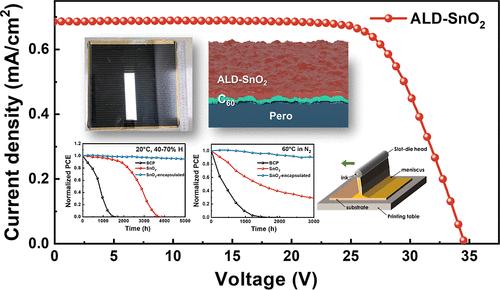实现商业规模的 Perovskite 太阳能电池:ALD-SnO2 缓冲层在性能和稳定性方面的作用
IF 8.3
2区 材料科学
Q1 MATERIALS SCIENCE, MULTIDISCIPLINARY
引用次数: 0
摘要
有机-无机混合型过氧化物太阳能电池(PSCs)因其卓越的光电特性而在光伏应用中展现出巨大的潜力。然而,PSC 中传统的 C60 电子传输层(ETL)存在覆盖不完全和金属扩散等问题,导致性能和稳定性下降。这项研究探索了二氧化锡原子层沉积(ALD)作为 C60 和电极之间夹层的功效,以提高器件的性能和稳定性。研究结果表明,与 BCP 层的 22.86% 相比,15 nm 的 ALD-SnO2 层可将功率转换效率 (PCE) 提高到 23.85%。此外,基于二氧化锰的器件还表现出优异的开路电压(VOC)、短路电流密度(JSC)和填充因子(FF)。采用 ALD-SnO2 的模块(30 × 30 厘米)在效率和均匀性方面都有显著提高,这表明其具有可扩展的商业应用潜力。光致发光(PL)和电化学阻抗光谱(EIS)分析证实了电荷提取的改善以及二氧化锡缓冲层重组的减少。这项研究表明,ALD-SnO2 是一种很有前途的 PSC 夹层候选材料,为提高过氧化物太阳能技术的效率和稳定性提供了一条途径。本文章由计算机程序翻译,如有差异,请以英文原文为准。

Toward Commercial-Scale Perovskite Solar Cells: The Role of ALD-SnO2 Buffer Layers in Performance and Stability
Hybrid organic–inorganic perovskite solar cells (PSCs) have shown significant potential in photovoltaic applications due to their superior optoelectronic properties. However, the conventional electron transport layer (ETL) of C60 in PSCs poses challenges such as incomplete coverage and metal diffusion, leading to reduced performance and stability. This work explores the efficacy of atomic layer deposition (ALD) of SnO2 as an interlayer between C60 and electrode to enhance the performance and stability of devices. Devices with varying SnO2 thicknesses were fabricated, revealing that a 15 nm ALD-SnO2 layer optimally improved the power conversion efficiency (PCE) to 23.85%, compared to the 22.86% achieved with a BCP layer. Moreover, the SnO2-based devices exhibited superior open-circuit voltage (VOC), short-circuit current density (JSC), and fill factor (FF). Modules (30 × 30 cm) with ALD-SnO2 demonstrated notable enhancements in efficiency and uniformity, suggesting the potential for scalable commercial applications. Photoluminescence (PL) and electrochemical impedance spectroscopy (EIS) analyses confirmed the improved charge extraction and reduced recombination with the SnO2 buffer layer. This research indicates that ALD-SnO2 is a promising interlayer candidate for PSCs, providing a pathway toward higher efficiency and stability in perovskite solar technology.
求助全文
通过发布文献求助,成功后即可免费获取论文全文。
去求助
来源期刊

ACS Applied Materials & Interfaces
工程技术-材料科学:综合
CiteScore
16.00
自引率
6.30%
发文量
4978
审稿时长
1.8 months
期刊介绍:
ACS Applied Materials & Interfaces is a leading interdisciplinary journal that brings together chemists, engineers, physicists, and biologists to explore the development and utilization of newly-discovered materials and interfacial processes for specific applications. Our journal has experienced remarkable growth since its establishment in 2009, both in terms of the number of articles published and the impact of the research showcased. We are proud to foster a truly global community, with the majority of published articles originating from outside the United States, reflecting the rapid growth of applied research worldwide.
 求助内容:
求助内容: 应助结果提醒方式:
应助结果提醒方式:


